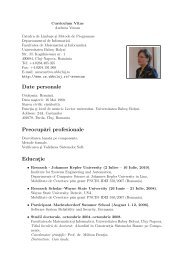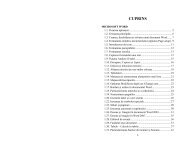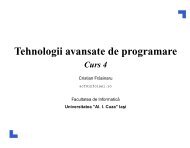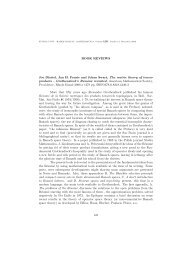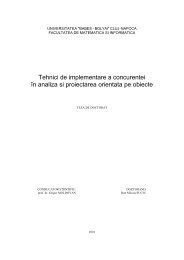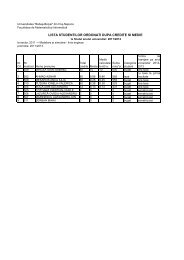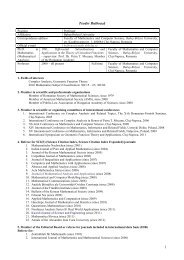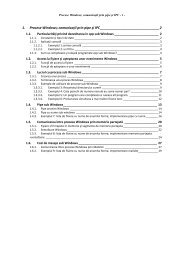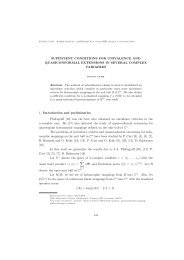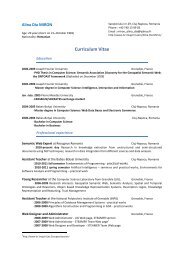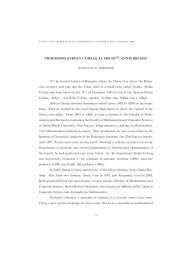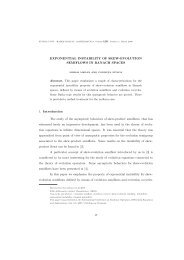CONTENTS
CONTENTS
CONTENTS
You also want an ePaper? Increase the reach of your titles
YUMPU automatically turns print PDFs into web optimized ePapers that Google loves.
KNOWLEDGE ENGINEERING: PRINCIPLES AND TECHNIQUES<br />
Proceedings of the International Conference on Knowledge Engineering,<br />
Principles and Techniques, KEPT2009<br />
Cluj-Napoca (Romania), July 2–4, 2009, pp. 223–226<br />
HIGH COUPLING DETECTION USING FUZZY CLUSTERING<br />
ANALYSIS<br />
CAMELIA S¸ERBAN (1)<br />
Abstract. Coupling is an important criterion when evaluating a software design<br />
because it captures a very desirable characteristic: a change to one part of a system<br />
should have a minimal impact on other parts. An excessive coupling plays a<br />
negative role on many external quality attributes like reusability, maintainability<br />
and testability.<br />
This paper aims at presenting a new approach concerning the identification<br />
of those classes with high coupling, from an object oriented system.<br />
1. Introduction<br />
In order to keep the software system easy to maintain, the assessment of its design<br />
according to well established principle and heuristics, has to be made through<br />
the entire development lifecycle. The principle of low coupling is reflected by all the<br />
authors [2, 3, 5] that propose design rules and heuristics for object-oriented programming.<br />
They all converge in saying that coupling should be kept low. A change to<br />
one part of a system it is important to have a minimal impact on other parts. Those<br />
design entities that could propagate a lot of changes in the system, if something has<br />
been changed inside them, have to be identified and reviewed.<br />
In this article, we our goal is to identify the design entities that are strongly<br />
coupled with the rest of the system. The approach is based on fuzzy clustering<br />
analysis. Some metrics are used in order to quantify those aspects consired important<br />
with regard to coupling.<br />
The remainder of this paper is organized as follows. Section 2 describes the<br />
theoretical background for our approach. Section 3 presents and discusses the experimental<br />
results obtained by applying the proposed approach on an open source<br />
application, called log4net [8]. Section 4 reviews related works in the area of detection<br />
design flaws. Finally, Section 5 summarizes the contributions of this work and<br />
outlines directions for further research.<br />
2000 Mathematics Subject Classification. 68N30, 03E72.<br />
Key words and phrases. coupling, metrics, fuzzy analisys.<br />
223<br />
c○2009 Babe¸s-Bolyai University, Cluj-Napoca



